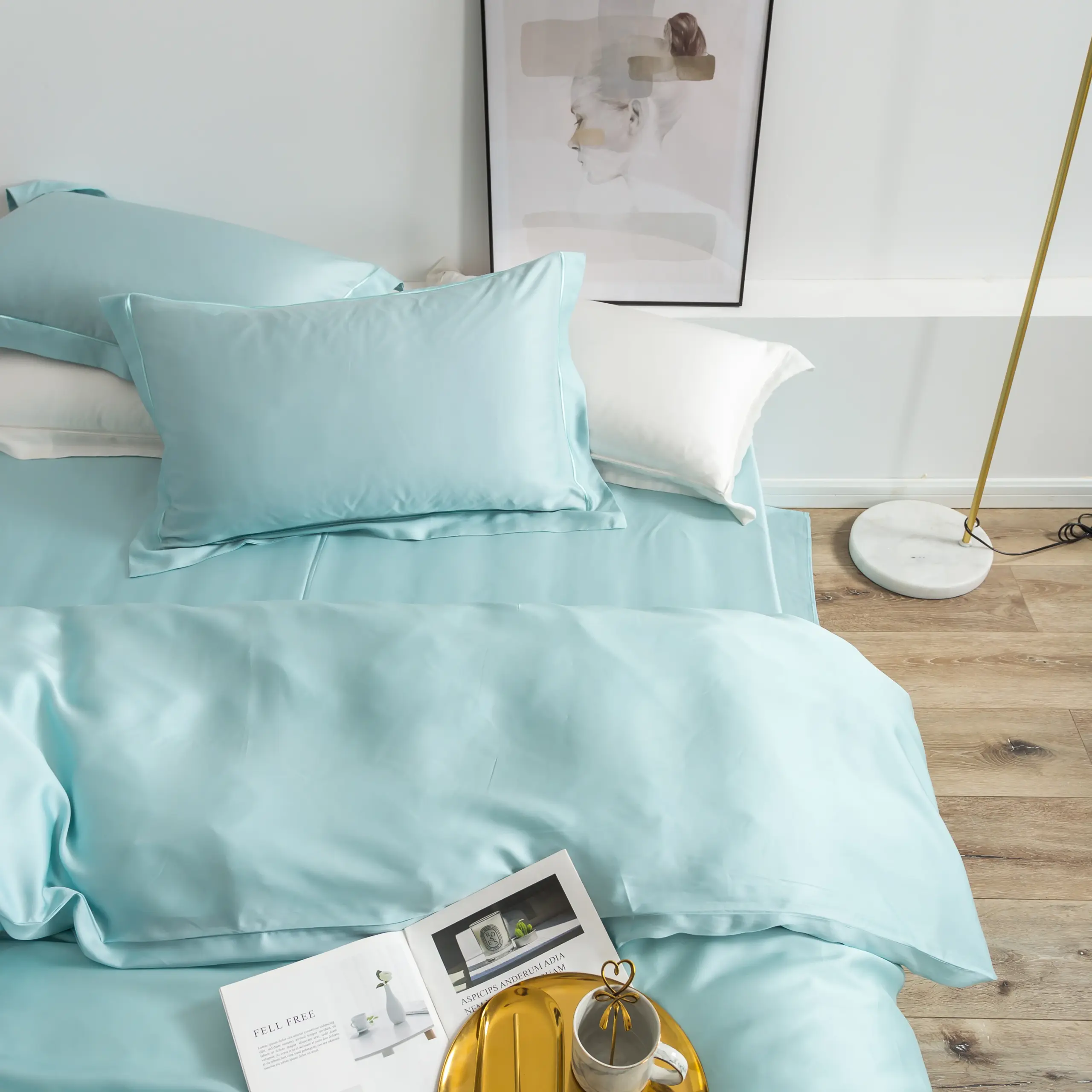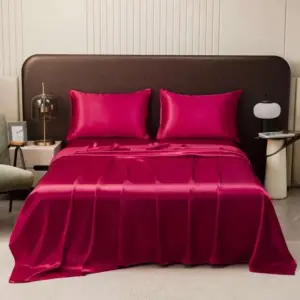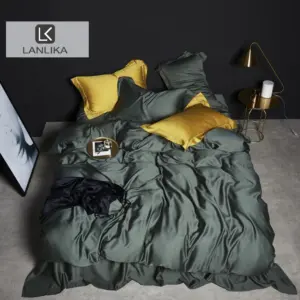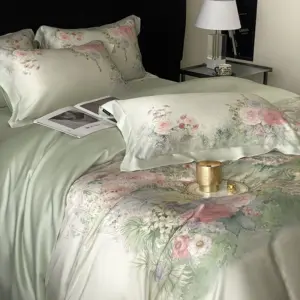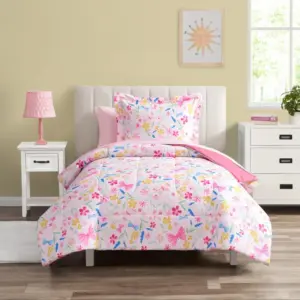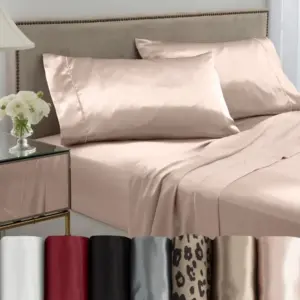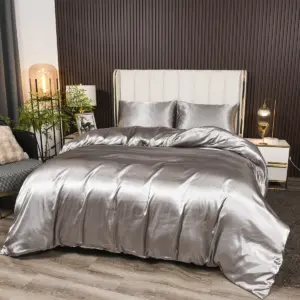Understanding Silk as a Premium Bedding Material
Silk stands apart in the world of bedding materials as a naturally luxurious fiber with a rich history spanning thousands of years. This remarkable material begins its journey as a protein fiber produced by silkworms (specifically Bombyx mori) as they spin their cocoons. Unlike synthetic alternatives or plant-based fabrics, silk offers a unique combination of properties that has made it prized throughout human history.
What makes silk truly special as a bedding material?
- Natural smoothness and sheen: Silk fibers have an incredibly smooth surface that creates both a visual luster and a uniquely soft feel against the skin
- Lightweight yet insulating: Despite its delicate appearance, silk provides excellent warmth without the heavy weight of many other bedding materials
- Natural temperature regulation: Silk adjusts to your body temperature, keeping you cool in summer and warm in winter
- Exceptional durability: When properly cared for, silk bedding can last for many years, often outlasting cotton alternatives
The complex production process of silk contributes to its luxury status. Each strand must be carefully harvested, processed, and woven, requiring significant expertise and time. This craftsmanship is why ultimate guide to silk bedding resources emphasize the material’s exceptional value.
When you invest in premium mulberry silk bedding sets, you’re not just purchasing sheets – you’re transforming your ordinary sleep experience into something truly extraordinary. Throughout this guide, we’ll explore everything you need to know about silk bedding, from understanding quality metrics to proper care techniques.
The Science Behind Silk’s Premium Quality
To truly appreciate what makes silk exceptional, we need to understand its molecular structure. Silk is composed primarily of two proteins: fibroin (the core structural component) and sericin (the sticky outer layer that binds fibroin fibers together). During silk production, the sericin is typically removed, leaving the smooth fibroin protein that gives silk its characteristic feel.
These natural protein fibers create several unique properties that directly benefit sleepers:
Natural Hypoallergenic Properties
The protein structure of silk naturally resists common allergens like dust mites, mold, and certain bacteria. This makes silk bedding particularly valuable for those with sensitive skin or respiratory concerns. Research has shown that silk bedding for allergy sufferers can provide significant relief compared to synthetic or plant-based alternatives.
Moisture Management
Silk fibers can absorb up to 30% of their weight in moisture without feeling damp. This remarkable quality helps maintain an ideal sleep environment by wicking away sweat while you sleep. The mulberry silk bedding skin benefits are directly tied to this moisture-regulating capability, which helps keep skin properly hydrated throughout the night.
Temperature Regulation
The natural structure of silk fibers includes tiny air pockets that provide insulation while allowing airflow. This creates a microclimate around your body that adjusts to your needs – cooling when you’re hot and warming when you’re cold. Unlike synthetic materials that can trap heat, silk breathes naturally, promoting comfortable, uninterrupted sleep.
Smooth Surface Structure
When examined under magnification, silk fibers reveal an incredibly smooth surface that creates minimal friction against skin and hair. This smoothness is not just a texture preference – it translates to tangible benefits for skin health and hair protection, which we’ll explore in greater detail later.
These natural properties work together to create bedding that doesn’t just feel luxurious, but actively contributes to your overall well-being through improved sleep quality.
Decoding Essential Silk Terminology
Understanding silk bedding requires familiarity with terminology unique to this premium material. These key concepts will help you evaluate quality and make informed purchasing decisions.
Understanding Momme Weight: The Measure of Silk Quality
Momme (pronounced “muh-mee” and abbreviated as “mm”) is the traditional measurement used to determine silk fabric density. Specifically, it refers to the weight in pounds of 100 yards of silk fabric that is 45 inches wide. The higher the momme count, the denser and more durable the silk.
Unlike thread count in cotton fabrics, momme weight provides a more accurate assessment of silk quality. Higher momme silk offers:
- Greater durability and longevity
- Enhanced opacity (less see-through)
- Richer feel and drape
- Better temperature regulation
Different silk items typically have different optimal momme ranges:
- 16-19mm: Lightweight silk appropriate for summer use or warmer climates
- 19-22mm: Mid-weight silk that provides versatility for year-round use
- 22-25mm: Heavyweight silk that offers maximum durability and luxury
For most bedding applications, 22 momme silk sheets provide an excellent balance between luxurious feel and practical durability. When evaluating true silk sheet quality, momme weight should be one of your primary considerations.
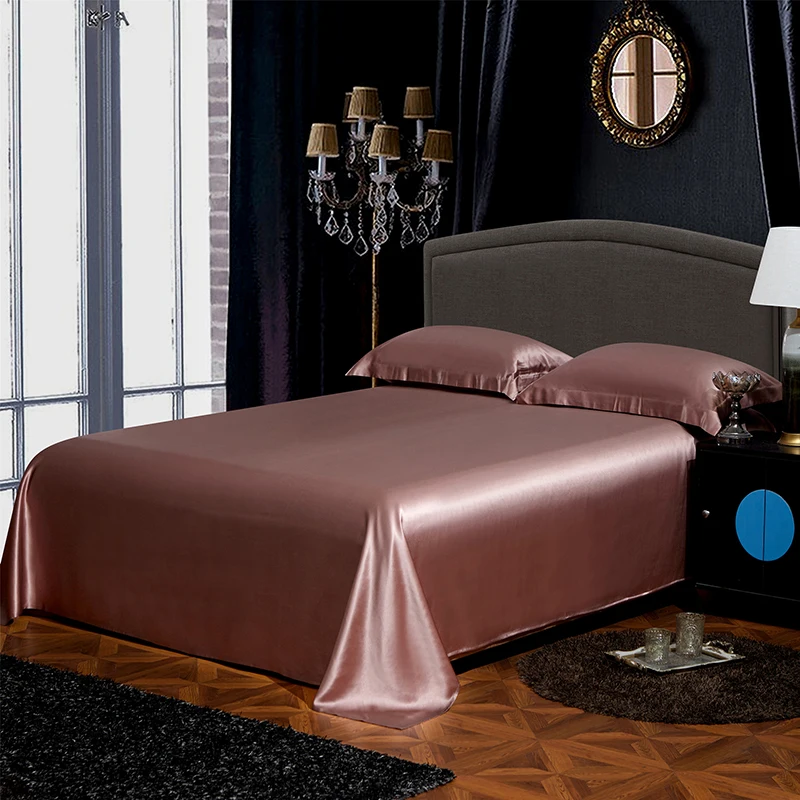
Silk Grade System Explained
Beyond momme weight, silk quality is also classified using a grading system that assesses fiber characteristics:
Grade 6A: The highest quality silk featuring the longest and most uniform fibers with minimal impurities. This grade offers exceptional smoothness, strength, and visual appeal.
Grade 5A: High-quality silk with very good fiber consistency and few impurities. Still premium but slightly less refined than 6A.
Grade 4A: Good quality silk with moderate fiber consistency and acceptable purity levels. A midrange option.
Grades 3A and below: Lower grades with shorter fibers, more inconsistencies, and potential impurities. Generally avoided in premium bedding.
These grades directly impact several aspects of the finished product:
- Texture uniformity (higher grades provide more consistent feel)
- Strength and durability (longer fibers create stronger fabric)
- Visual luster and appearance (more uniform fibers reflect light more consistently)
- Overall quality feel (smoother surface with fewer imperfections)
To verify authentic silk, many experts recommend simple tests like the “burn test” (silk smells like burning hair and leaves crushable ash) or the “ring test” (genuine silk can be pulled through a ring due to its fine, compressible nature).
Types of Silk Used in Premium Bedding
Not all silk is created equal. Understanding the different varieties can help you identify truly premium options for your bedding.
Mulberry Silk: The Gold Standard
Mulberry silk represents the pinnacle of silk quality and accounts for approximately 90% of the world’s commercial silk production. This variety comes from silkworms (Bombyx mori) that are fed exclusively on mulberry leaves under carefully controlled conditions.
What makes Mulberry silk exceptional:
- Long, continuous fibers: Individual strands can reach up to 900 meters in length
- Consistent texture: The controlled diet of the silkworms produces uniform, smooth fibers
- Superior strength: Despite its delicate appearance, properly processed Mulberry silk is remarkably strong
- Natural white color: Makes it ideal for dyeing in vibrant, consistent colors
- Hypoallergenic properties: Particularly gentle for sensitive skin
When exploring luxury silk bedding sets or reading the ultimate guide to luxury silk bedding, you’ll find that Mulberry silk is almost always the preferred choice for premium applications.
Other Silk Varieties
While Mulberry silk dominates the luxury bedding market, other varieties exist:
Tussah/Wild Silk: Produced by wild silkworms with a varied diet, resulting in:
– Shorter, less uniform fibers
– More textured, less smooth surface
– Natural golden or tan color
– Greater durability but less refinement
Peace Silk/Ahimsa Silk: Created by allowing the silkworm to complete its lifecycle:
– Ethical production focus
– Slightly less refined appearance
– Shorter fibers (collected after moth emergence)
– Similar benefits but with slightly different texture
Muga Silk: A rare golden silk from Assam, India:
– Natural golden color that improves with washing
– Extremely durable
– Limited availability
– Traditionally used for special garments
For bedding applications where comfort, smoothness, and consistent quality are paramount, Mulberry silk remains the overwhelming choice of luxury bedding manufacturers and discerning customers alike.
The Exceptional Benefits of Sleeping on Silk
Switching to silk bedding offers numerous advantages that extend beyond simple luxury. These benefits directly impact your comfort, appearance, and overall well-being.
Skin Benefits: Beyond Beauty Sleep
The relationship between silk bedding and skin health is well-established. Unlike cotton and other materials that can draw moisture from your skin, silk helps maintain optimal hydration levels. The smooth surface creates minimal friction against facial skin, which offers several key benefits:
- Reduced sleep creases: The smooth surface minimizes compression and folding of facial skin
- Preserved skincare products: Silk absorbs less of your nighttime skincare products than cotton, allowing them to work on your skin rather than your pillowcase
- Maintained natural moisture: By not wicking away beneficial natural oils, silk helps prevent dryness and irritation
- Minimized irritation: Particularly beneficial for sensitive skin conditions like eczema, rosacea, or acne
Dermatologists often recommend high-quality silk pillowcases specifically for their skin benefits. The natural amino acids present in silk fibers are also compatible with human skin, creating a gentle surface that works with your body’s natural processes rather than against them.

Hair Care Benefits: Preserve Your Style While You Sleep
Cotton pillowcases create significant friction against your hair as you move during sleep. This friction can lead to:
– Hair breakage and split ends
– Increased frizz and tangles
– Disruption of styled hair
– Dryness due to absorption of natural oils
Silk’s smooth surface dramatically reduces this friction, allowing your hair to glide across the pillowcase rather than catching and pulling. This provides several specific advantages:
- Reduced breakage: Particularly beneficial for fine or fragile hair
- Maintained styles: Curly, wavy, or professionally styled hair stays intact longer
- Less frizz: Wake up with smoother, more manageable hair
- Preserved moisture: Natural oils remain in your hair rather than transferring to your pillowcase
People who switch from cotton to silk pillowcases often report noticeable improvements in hair condition within just one week, with less breakage, reduced frizz, and better style retention.
Full-size Silk Sheets, King Size Silk Sheets, Queen Size Silk Sheets, Twin Size Silk Sheets, Washable Silk Sheets
Price range: $95.95 through $178.37 Select options This product has multiple variants. The options may be chosen on the product page100% Silk Sheets, Green Silk Sheets, King Size Silk Bedding Set, Mulberry Silk Bedding Sets, Queen Size Silk Bedding Set
Price range: $1,246.21 through $1,615.22 Select options This product has multiple variants. The options may be chosen on the product pageEucalyptus Silk Bedding Sets, Eucalyptus Silk Sheets
Price range: $360.24 through $393.60 Select options This product has multiple variants. The options may be chosen on the product pagePink Silk Sheets, Twin Size Silk Sheets
$171.80 Select options This product has multiple variants. The options may be chosen on the product pageFull-size Silk Sheets, Pink Silk Sheets
$136.31 Select options This product has multiple variants. The options may be chosen on the product pageGrey Silk Sheets, Silk Sheet and Pillowcase Set
Price range: $88.20 through $146.64 Select options This product has multiple variants. The options may be chosen on the product page
Silk vs. Other Bedding Materials: Making the Distinction
Understanding how silk compares to other common bedding materials helps clarify its unique position in the premium bedding market.
Silk vs. Satin: Natural Fiber vs. Weave Type
One of the most common misconceptions is that silk and satin are similar materials. In reality:
- Silk is a natural protein fiber produced by silkworms
- Satin is a weave type that can be made from various fibers (polyester, nylon, rayon, or even silk)
While satin made from synthetic materials can mimic silk’s appearance, it lacks the natural benefits of true silk, including temperature regulation, moisture management, and hypoallergenic properties. A comprehensive silk vs cotton bedding comparison reveals significant differences in performance and comfort.
Silk vs. Cotton
Cotton is the most common bedding material, but differs from silk in several important ways:
| Feature | Silk | Cotton |
|---|---|---|
| Moisture absorption | Absorbs up to 30% without feeling damp | Highly absorbent but retains moisture |
| Temperature regulation | Naturally regulates temperature | Can retain heat and feel clammy |
| Skin/hair friction | Very low friction surface | Higher friction that can cause irritation |
| Durability | Very durable with proper care | Durable but may pill over time |
| Maintenance | Requires gentle washing | Easier to care for |
Silk vs. Bamboo
Bamboo bedding has gained popularity as an eco-friendly option:
- Both offer good temperature regulation, though silk tends to be superior
- Bamboo is typically less expensive than silk
- Silk offers better benefits for skin and hair
- Bamboo processing may involve harsh chemicals despite natural source material
Silk vs. Synthetic Alternatives
Synthetic bedding materials like polyester microfiber attempt to mimic silk’s feel at a lower price point:
- Synthetics typically lack true temperature regulation
- They don’t offer the same skin and hair benefits
- Synthetics may trap heat and cause night sweats
- The lifespan is generally shorter than well-maintained silk
For those seeking the full range of benefits, genuine silk sheets provide advantages that alternative materials simply cannot match.
Essential Care Guide for Silk Bedding
Proper care is essential to maintain the beauty and performance of silk bedding. While silk requires more attention than cotton, the right care routine is straightforward and ensures your investment lasts for years.
Washing Instructions
Hand Washing (Preferred Method):
1. Fill a basin with cold water
2. Add a small amount of pH-neutral or silk-specific detergent
3. Gently agitate the silk for 2-3 minutes
4. Rinse thoroughly with cold water until no soap remains
5. Press (don’t wring) to remove excess water
Machine Washing (If Necessary):
1. Use a mesh laundry bag to protect the silk
2. Select the delicate/silk cycle with cold water
3. Use minimal silk-specific detergent
4. Avoid fabric softeners, bleach, or enzymatic cleaners
Products to Avoid
- Bleach (damages silk fibers irreparably)
- Fabric softeners (coats fibers and reduces benefits)
- Enzyme-based detergents (breaks down protein fibers)
- Hot water (can shrink and damage silk)
Drying Methods
- Never use a dryer
- Lay flat on a clean, dry towel
- Roll the towel with silk inside to absorb excess moisture
- Unroll and lay flat to air dry
- Keep away from direct sunlight and heat sources
- If ironing is necessary, use the lowest silk setting and iron inside out
Storage Recommendations
- Ensure silk is completely dry before storing
- Store in a breathable cotton bag, not plastic
- Keep in a cool, dry place away from sunlight
- Avoid hanging silk sheets as this can stretch the fibers
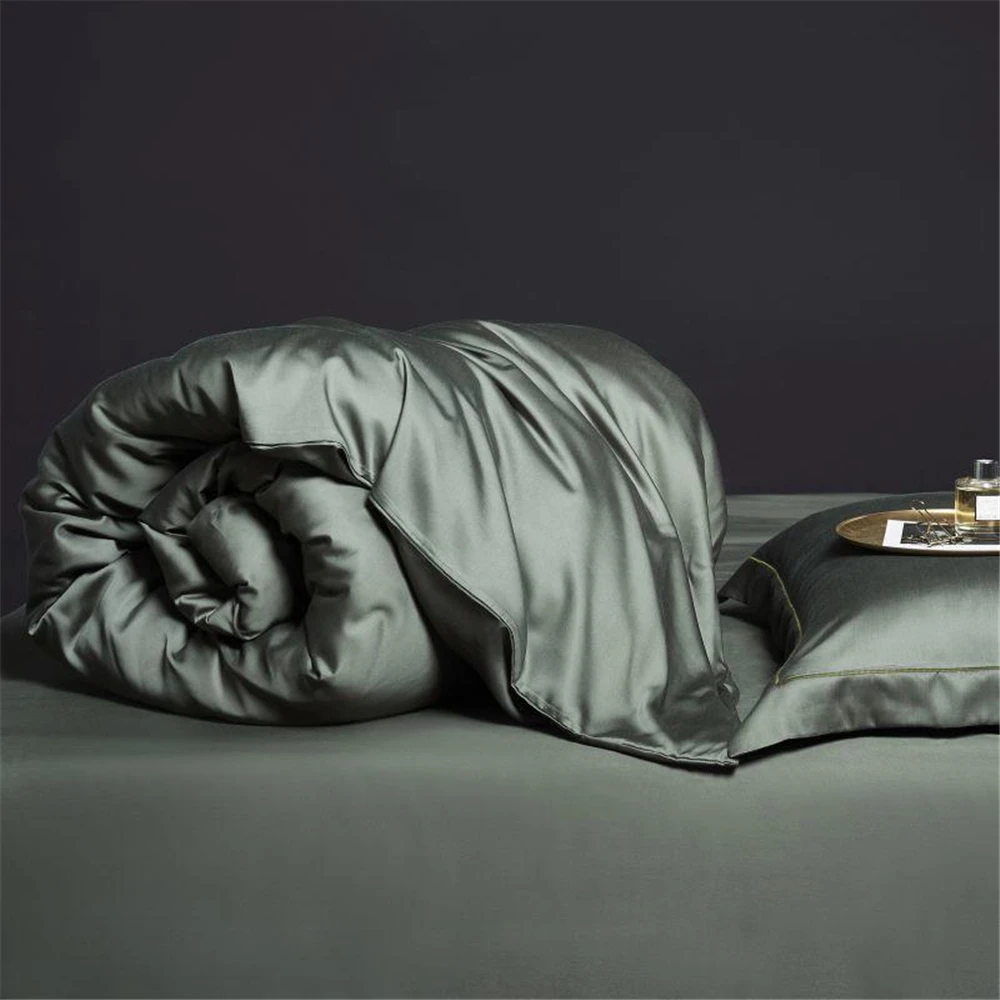
How to Select High-Quality Silk Bedding
Armed with knowledge about silk types and quality indicators, you can make informed decisions when purchasing silk bedding. Here’s a comprehensive guide to selecting the best silk bedding for your needs.
Quality Verification Checklist
Confirm Material Authenticity: Look for labels specifying “100% Mulberry Silk” rather than terms like “silk blend,” “art silk,” or “silk-like.”
Check Momme Weight:
– For pillowcases: 19-22mm is ideal
– For sheets and duvet covers: 22-25mm offers the best balance of luxury and durability
– Avoid products that don’t specify momme weightVerify Silk Grade: Seek Grade 6A silk for premium bedding. Lower grades may be acceptable for less critical applications.
Look for Certifications: OEKO-TEX Standard 100 certification ensures the fabric is free from harmful chemicals and safe for direct skin contact.
Examine Construction Details:
– Finished seams with no loose threads
– Properly aligned patterns
– Secure closures (envelope closures for pillowcases, strong buttons for duvet covers)
– Consistent color throughoutConsider Color Process: Natural dyes or certified non-toxic dyes are preferable for both environmental reasons and skin sensitivity.
When researching what’s included in silk bedding sets or how to choose full silk bedding, these quality indicators should guide your decision-making process. High-quality silk from brands like Sanctuary Soft consistently meets these standards.
Common Questions About Silk Bedding
Is silk bedding worth the investment?
While silk bedding requires a higher initial investment than cotton or synthetic alternatives, its durability, comfort benefits, and positive impacts on skin and hair make it worthwhile for many people. When properly maintained, high-quality silk bedding can last for many years, making it cost-effective over time. Many customers find that the improved sleep quality and skin/hair benefits alone justify the price. Research on silk bedsheet value consistently shows high satisfaction rates among owners.
How long does silk bedding typically last?
With proper care, high-quality silk bedding can last 5-10 years or more. This longevity makes it comparable to or better than premium cotton, which typically needs replacement every 2-3 years due to pilling, thinning, and color fading.
Is silk bedding suitable for all seasons?
Yes. Silk’s natural temperature regulation properties make it ideal for year-round use. It helps keep you cool in summer by wicking away moisture and warm in winter through its insulating properties.
Can silk bedding be machine washed?
While hand washing is preferable, many modern silk bedding products can be machine washed on a gentle cycle with cold water and appropriate detergent. Always check the manufacturer’s specific care instructions.
How do I know if I’m buying real silk?
Real silk has a distinctive smooth feel and natural luster that changes subtly as light hits it from different angles. The burn test (small thread burns with an odor similar to burning hair) and price point (genuine silk is rarely inexpensive) can also help identify authentic products.
Vegan Alternatives to Traditional Silk
For those who prefer plant-based bedding options, several alternatives offer similar benefits to traditional silk:
Bamboo Silk
Made from bamboo fibers processed into a smooth fabric, bamboo silk offers:
– Natural temperature regulation (though less effective than true silk)
– Hypoallergenic properties
– Smooth texture with minimal friction
– More affordable price point
– Sustainable resource base
Cupro
Derived from cotton linter (the fine fibers around cotton seeds):
– Silky smooth texture
– Good moisture-wicking properties
– Biodegradable material
– Less expensive than silk
– Plant-based production
Other Innovative Alternatives
The textile industry continues to develop new options like lyocell, modal, and other plant-based fabrics that mimic certain silk properties. While these vegan silk bedding options don’t perfectly replicate all of silk’s unique benefits, they provide ethical alternatives for those who avoid animal products.
Creating Your Perfect Silk Sleep Sanctuary
Building your ideal silk bedding collection can be done gradually, starting with key pieces and expanding over time.
Essential Pieces to Consider
Silk Pillowcases: The perfect entry point to silk bedding, offering immediate skin and hair benefits with minimal investment.
Silk Sheets: For full-body benefits and the complete silk sleep experience. A fitted sheet and flat sheet combination provides comprehensive coverage.
Silk Duvet Cover: Adds temperature regulation to your existing comforter while providing a luxurious look and feel.
Silk Sleep Mask: Enhances sleep quality by blocking light while providing the skin benefits of silk around the delicate eye area.
Color and Style Recommendations
Silk naturally enhances any color due to its characteristic luster. Consider:
– Classic whites and ivories for a timeless, hotel-luxury feel
– Soft pastels that showcase silk’s natural sheen
– Rich jewel tones for dramatic bedroom statements
– Neutral colors that coordinate easily with existing décor
When creating your silk bedding essentials for comfort, focus on quality over quantity. Starting with one or two exceptional pieces is better than compromising on quality to purchase a complete set immediately.
By applying the knowledge from this guide, you can transform your bedroom into a luxurious sleep sanctuary that not only looks beautiful but actively contributes to your well-being through better sleep, healthier skin, and stronger hair.

